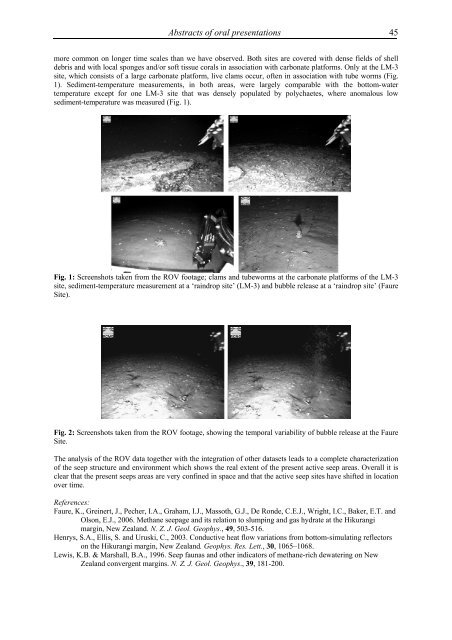Ninth international conference on - Marum
Ninth international conference on - Marum
Ninth international conference on - Marum
You also want an ePaper? Increase the reach of your titles
YUMPU automatically turns print PDFs into web optimized ePapers that Google loves.
Abstracts of oral presentati<strong>on</strong>s 45<br />
more comm<strong>on</strong> <strong>on</strong> l<strong>on</strong>ger time scales than we have observed. Both sites are covered with dense fields of shell<br />
debris and with local sp<strong>on</strong>ges and/or soft tissue corals in associati<strong>on</strong> with carb<strong>on</strong>ate platforms. Only at the LM-3<br />
site, which c<strong>on</strong>sists of a large carb<strong>on</strong>ate platform, live clams occur, often in associati<strong>on</strong> with tube worms (Fig.<br />
1). Sediment-temperature measurements, in both areas, were largely comparable with the bottom-water<br />
temperature except for <strong>on</strong>e LM-3 site that was densely populated by polychaetes, where anomalous low<br />
sediment-temperature was measured (Fig. 1).<br />
Fig. 1: Screenshots taken from the ROV footage; clams and tubeworms at the carb<strong>on</strong>ate platforms of the LM-3<br />
site, sediment-temperature measurement at a ‘raindrop site’ (LM-3) and bubble release at a ‘raindrop site’ (Faure<br />
Site).<br />
Fig. 2: Screenshots taken from the ROV footage, showing the temporal variability of bubble release at the Faure<br />
Site.<br />
The analysis of the ROV data together with the integrati<strong>on</strong> of other datasets leads to a complete characterizati<strong>on</strong><br />
of the seep structure and envir<strong>on</strong>ment which shows the real extent of the present active seep areas. Overall it is<br />
clear that the present seeps areas are very c<strong>on</strong>fined in space and that the active seep sites have shifted in locati<strong>on</strong><br />
over time.<br />
References:<br />
Faure, K., Greinert, J., Pecher, I.A., Graham, I.J., Massoth, G.J., De R<strong>on</strong>de, C.E.J., Wright, I.C., Baker, E.T. and<br />
Ols<strong>on</strong>, E.J., 2006. Methane seepage and its relati<strong>on</strong> to slumping and gas hydrate at the Hikurangi<br />
margin, New Zealand. N. Z. J. Geol. Geophys., 49, 503-516.<br />
Henrys, S.A., Ellis, S. and Uruski, C., 2003. C<strong>on</strong>ductive heat flow variati<strong>on</strong>s from bottom-simulating reflectors<br />
<strong>on</strong> the Hikurangi margin, New Zealand. Geophys. Res. Lett., 30, 1065–1068.<br />
Lewis, K.B. & Marshall, B.A., 1996. Seep faunas and other indicators of methane-rich dewatering <strong>on</strong> New<br />
Zealand c<strong>on</strong>vergent margins. N. Z. J. Geol. Geophys., 39, 181-200.














